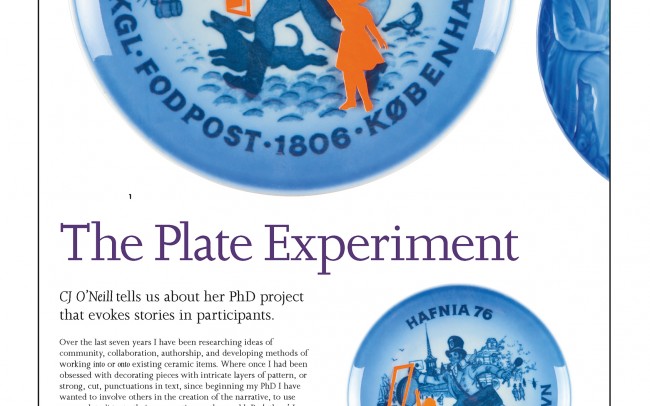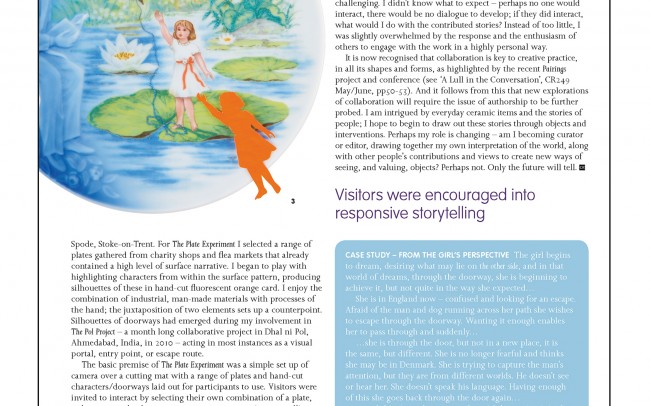The Plate Experiment: Ceramic Review
A commissioned article for Ceramic Review Issue 257 2012 about The Plate Experiment.
The Plate Experiment
CJ O’Neill tells us about her PhD project that evokes stories in participants.
Over the last seven years of my practice I have been researching ideas of community, collaboration, authorship, and developing methods of working into or onto existing ceramic items. Where once I had been obsessed with decorating pieces with intricate layers of pattern, or strong, cut, punctuations in text, since beginning my PhD I have wanted to involve others in the creation of the narrative, to use my work to listen to their perspective on the world. (By the term others I refer to an-other person; this can be wide and varying in nature. It is a deliberately open term that allows for exploration of the possibilities this may bring)
READYMADES AND FLUORESCENT FIGURES In order to do this I devised a piece called The Plate Experiment to show in an exposition, State of Play, a PhD work in progress show at RIBA Hub, Manchester, July 2011, and again as part of the British Ceramics Biennial at Spode, Stoke-on-Trent. For The Plate Experiment I selected a range of plates gathered from charity shops and flea markets that already contained a high level of surface narrative. I began to play with highlighting characters from within the surface pattern, producing silhouettes of these in hand-cut fluorescent orange card. I enjoy the combination of industrial, man-made materials with processes of the hand; the juxtaposition of the two elements set up a counterpoint. Silhouettes of doorways had emerged during my involvement in The Pol Project, a month long collaborative project in Dhal ni Pol, Ahmedabad, India in 2010. (www.thepolproject.blogspot.com) acting in most instances as a visual portal, entry point, or escape route.
The basic premise of The Plate Experiment was a simple set up of camera over a cutting mat with a range of plates and hand-cut characters/doorways laid out for participants to use. Visitors were invited to interact by selecting their own combination of a plate, a character, and a doorway, to encourage responsive storytelling. Participants were invited to create a scene with the materials and then write a short statement about the story they imagined; each story was separate and people didn’t see the others’ stories.
AUTHORSHIP My subsequent processing of this information unexpectedly highlighted issues around authorship. Whose work is this? How are the others I invited to be involved in this process actually acknowledged? The piece presented below cites a number of authors, and is one way of addressing this issue. It is crafted by me from the combined contributions made during The Plate Experiment at State of Play by Helen Felcey, Pui Lee, CJ O’Neill, Sonia Sanchez-Lopez, and Sylvianne Sykes.
CASE STUDY – FROM THE GIRL’S PERSPECTIVE The girl begins to dream, desiring what may lie on the other side, and in that world of dreams, through the doorway, she is beginning to achieve it, but not quite in the way she expected…
She is in England now – confused and looking for an escape. Afraid of the man and dog running across her path she wishes to escape through the doorway. Wanting it enough enables her to pass through and suddenly…
… she is through the door, but not in a new place, it is the same, but different. She is no longer fearful and thinks she may be in Denmark. She is trying to capture the man’s attention, but they are from different worlds. He doesn’t see or hear her. She doesn’t speak his language. Having enough of this she goes back through the door again…
… and this time, she sees another girl, but wait – it is also her, another version? She grabs at her skirt; tries to hold onto her; to pull her down to earth; to lift her skirt up; anything to get her attention. Is she magical? Is she real? Is she nothing? ‘Non-existent’ in a sense. Suddenly she feels very scared. Where exactly is she? Who is this girl with no name? There is no doorway, no way to get home. ‘Is this my life?’ she worries…
SHARED TECHNIQUES On reflection I see that the process of creating this narrative is the same process that I use when constructing a ceramic piece, working with layers and symbols to create a thread, a connection, between disparate parts. Inviting others into this process has been enlightening, liberating, and challenging. I didn’t know what to expect – perhaps no one would interact, there would be no dialogue to develop; if they did interact, what would I do with the contributed stories? Instead of too little, I was slightly overwhelmed by the response and the enthusiasm of others to engage with the work in a highly personal way.
It is now recognised that collaboration is key to creative practice, in all its shapes and forms as highlighted by the recent Pairings project and conference (www.miriad.mmu.ac.uk/pairings/). And it follows from this that new explorations of collaboration will require the issue of authorship to be further probed. I am intrigued by everyday ceramic items and the stories of people; I hope to begin to draw out these stories through objects and interventions. Perhaps my role is changing – am I becoming curator or editor, drawing together my own interpretation of the world, along with other people’s contributions and views to create new ways of seeing, and valuing, objects? Perhaps not. Only the future will tell.
Article originally published in Issue 257 of Ceramic Review.


